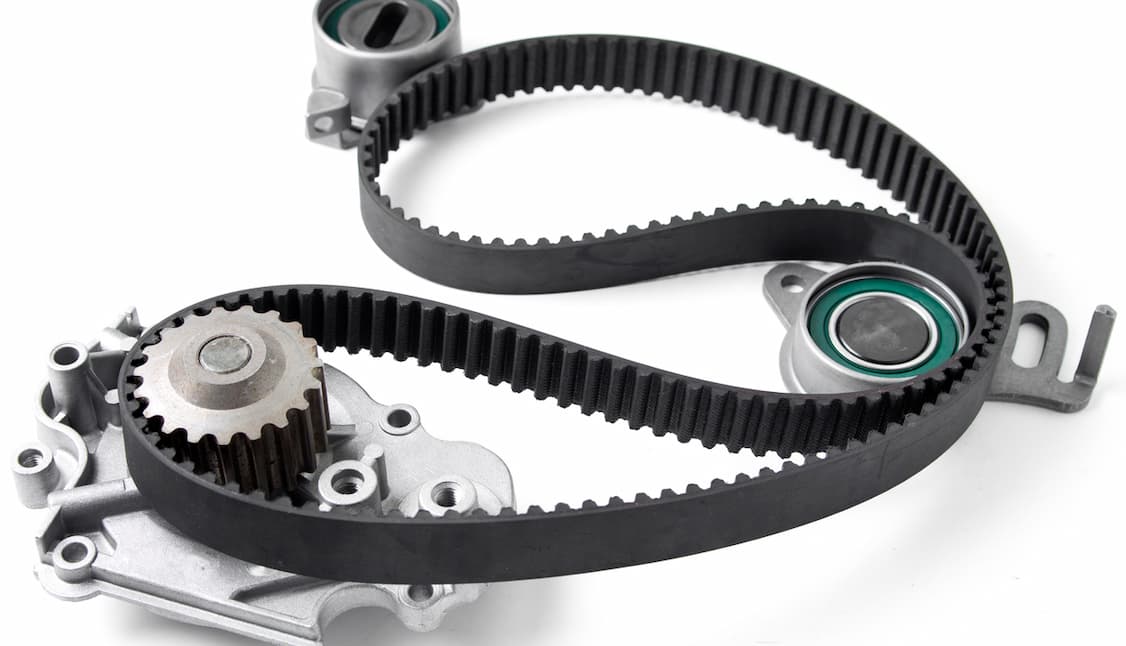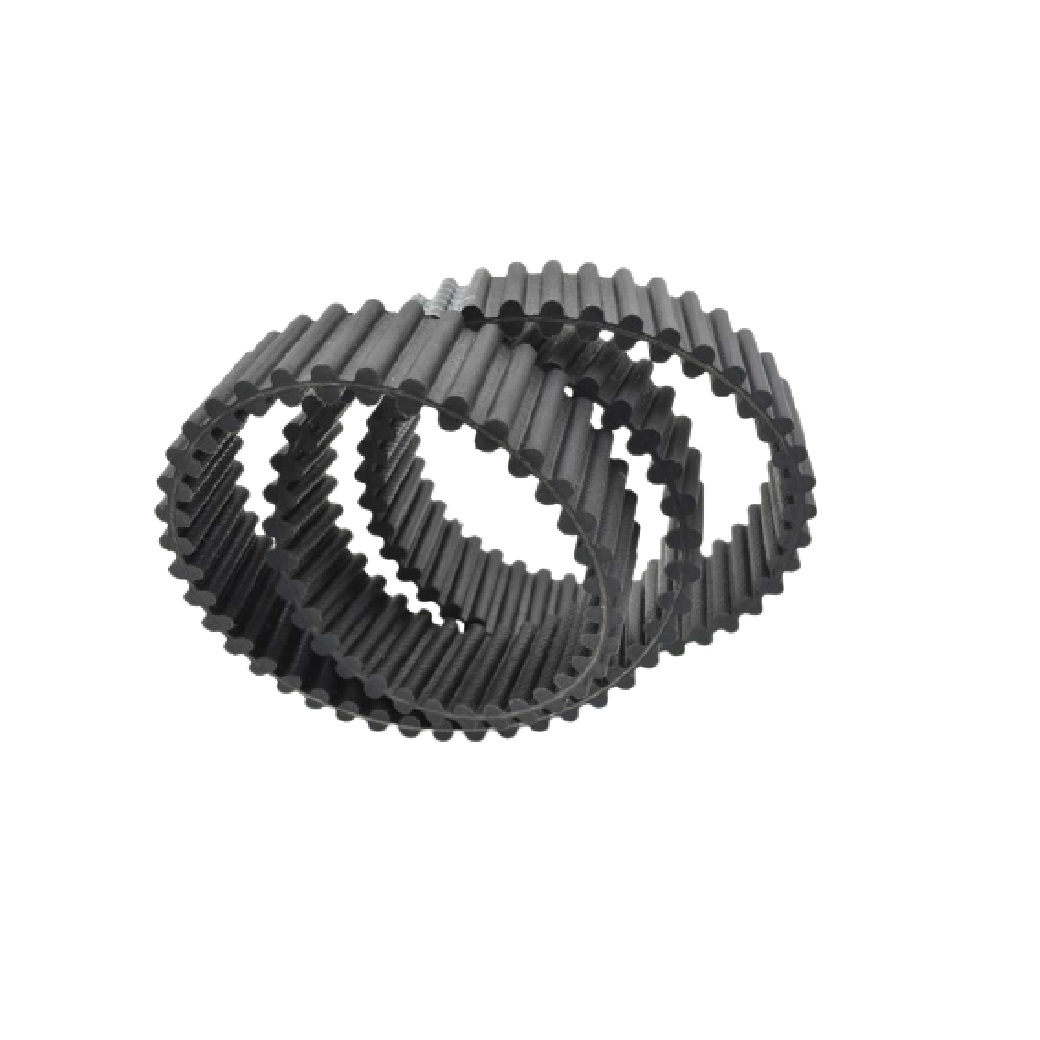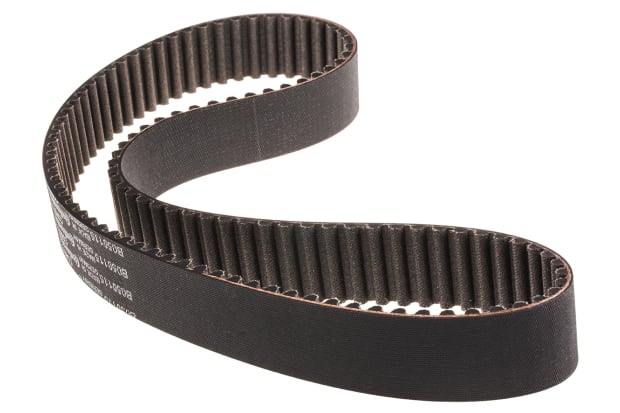Product Description
INDUSTRIAL TIMING BELT ( SYNCHRONOUS BELT )
. Feature
Our Timing Belt uses Japan-imported high quality synthetic neoprene, high quality glass fiber cord and tooth surface with nylon 66 high stretch do the protection. The timing belt adapts teeth or teeth mesh to transfer power. It needs no lubrication, no slip, no pollution, less noise. The transmission efficiency is over 98%, and the speed ratio can reach 1:10. Linear velocity can be up to 50m/s. Its dynamic bending wind gives a good fatigue performance, and good aging heat-resistance abrasion performance.
. Parameters
Figure 1. Physicomechanical Property
| Item | Trapezoid Teeth | Arc Teeth | ||||||||
| XL | L | H | XH | XXH | 3M | 5M | 8M | 14M | 20M | |
| Tensile Strength N/mm | 80 | 120 | 270 | 380 | 450 | 90 | 160 | 300 | 400 | 520 |
| Elongation Reference at Loading N | 60 | 90 | 220 | 300 | 360 | 70 | 130 | 240 | 320 | 410 |
| Adhesion strength of cloth N/mm | 5 | 6.5 | 8 | 10 | 12 | – | 6 | 10 | 12 | 15 |
| Adhesion strength of core N/mm | 200 | 300 | 600 | 800 | 1500 | – | 400 | 700 | 1200 | 1600 |
| Gear shearing intensity N/mm | 50 | 60 | 70 | 75 | 90 | – | 50 | 60 | 80 | 100 |
| Elongation ≤ % | 4% | |||||||||
| Hardness Shore A | 75 ± 5 | |||||||||
Figure 2: Belt Teeth Size
| Type | Pitch (pb) mm | Tooth height (ht) mm | Belt thick (hs) mm | Angle |
| MXL | 2.032 | 0.51 | 1.14 | 40º |
| XXL | 3.175 | 0.76 | 1.52 | 40º |
| XL | 5.080 | 1.27 | 2.3 | 40º |
| L | 9.525 | 1.91 | 3.6 | 40º |
| H | 12.7 | 2.29 | 4.3 | 40º |
| XH | 22.225 | 6.35 | 11.2 | 40º |
| XXH | 31.7 | 9.53 | 15.7 | 40º |
| T2.5 | 2.5 | 0.7 | 1.3 | 40º |
| T5 | 5.0 | 1.2 | 2.2 | 40º |
| T10 | 10 | 2.5 | 4.5 | 40º |
| T20 | 20 | 5.0 | 8.0 | 40º |
| AT5 | 5.0 | 1.2 | 2.7 | 40º |
| AT10 | 10 | 2.5 | 5.0 | 40º |
| AT20 | 20 | 5.0 | 8.0 | 40º |
. Production Equipment
01, pulley CNC processing zone 02, synchronous belt making machine 03, synchronous round roll teeth processing zone
04, synchornous belt curing processing zone 05, 3 roll calender 06, direct drive belt forming machine
07, pulley workshop timing CZPT
. Quality Testing
FAQ
Q1. Can I have a sample order?
Yes, any sample order is welcome to know the quality of our products.
Q2. What about the lead time of the sample or the final order?
2-5 days for normal sample.
20-30 days for a formal order.
Q3. How much is the minimum quantity for each item in 1 order?
One CZPT quantity is ok. Usually around 100pcs for small item, several dozens for big item.
Q4. Is it possible to print our logo or brand on the belt?
Yes, we can print your logo or design on the belt after receipt of your formal authorization letter of the logo or your brand.
Q5. Do you offer the guarantee for your product?
Yes, usually we offer 1 year warranty for all of our products.
/* March 10, 2571 17:59:20 */!function(){function s(e,r){var a,o={};try{e&&e.split(“,”).forEach(function(e,t){e&&(a=e.match(/(.*?):(.*)$/))&&1
| Standard or Nonstandard: | Standard |
|---|---|
| Application: | Electric Cars, Motorcycle, Car |
| Feature: | Wear-Resistant, High Temperature-Resistance |
| Tensile Strength: | Strong |
| Material: | Rubber |
| Type: | Toothed Belt |
| Samples: |
US$ 0.1/Piece
1 Piece(Min.Order) | |
|---|
| Customization: |
Available
| Customized Request |
|---|
Are there specific considerations for choosing V-belt tensioners in applications with varying loads or environmental conditions?
When selecting V-belt tensioners for applications with varying loads or environmental conditions, several specific considerations come into play. The dynamic nature of load changes and the presence of challenging environmental factors can significantly impact the performance and reliability of the tensioners. Here’s a detailed explanation of the specific considerations for choosing V-belt tensioners in such applications:
- Load Variation:
- Adjustability: Look for tensioners that offer adjustability, such as those with slotted mounting holes or adjustable arms. This allows for easy tension adjustment to accommodate load variations and maintain the proper belt tension.
- Spring-Loaded Tensioners: Spring-loaded tensioners are particularly useful in applications with load fluctuations. The spring mechanism automatically adjusts the tension to compensate for belt elongation or changes in load, ensuring consistent tension and minimizing belt slippage.
- Multi-Tensioner Systems: In applications with significant load variations, employing multiple tensioners strategically positioned along the belt path can help distribute the tension more evenly. This ensures that each section of the belt receives the appropriate tension, reducing the risk of belt slippage and optimizing power transmission.
- Environmental Conditions:
- Corrosion Resistance: In corrosive environments, such as those with high humidity or exposure to chemicals, choose tensioners with corrosion-resistant materials or coatings. Stainless steel or materials with zinc or chrome plating provide effective protection against corrosion.
- Temperature Resistance: Extreme temperatures can affect the mechanical properties of tensioners. Ensure that the chosen tensioners can withstand the temperature range of the application without compromising their performance or structural integrity.
- Contaminant Resistance: Some applications may involve the presence of contaminants like dust, dirt, or debris. Tensioners with sealed bearings or protective covers can help prevent the ingress of contaminants, minimizing the risk of damage and ensuring smooth operation.
- Weatherproofing: In outdoor applications exposed to weather elements, consider tensioners with weatherproof features or additional protective measures to prevent water or moisture ingress and maintain reliable performance.
- System Monitoring and Maintenance:
- Periodic Inspection: Implement a regular inspection schedule to check the condition of the tensioners, belts, and pulleys. Look for signs of wear, misalignment, or damage, and address any issues promptly.
- Belt Tension Measurement: Utilize belt tension measurement tools to monitor and verify the tension levels. Adjust the tension as needed to accommodate load variations and maintain optimal belt performance.
- Lubrication: If the tensioners have moving parts or bearings, ensure proper lubrication as per the manufacturer’s recommendations. This helps to reduce friction, minimize wear, and extend the life of the tensioners.
- Record Keeping: Maintain records of maintenance activities, including tension adjustments, inspections, and replacements. This facilitates tracking the performance of the tensioners over time and aids in identifying any recurring issues.
In applications with varying loads, it’s essential to choose tensioners that can adapt to these changes and maintain optimal belt tension. Considerations include:
Environmental conditions can have a substantial impact on the performance and longevity of V-belt tensioners. Considerations include:
In applications with varying loads or challenging environmental conditions, proactive monitoring and regular maintenance are crucial to ensure optimal performance. Consider the following:
By considering these specific factors when choosing V-belt tensioners for applications with varying loads or environmental conditions, you can ensure that the selected tensioners are capable of adapting to load changes, withstand challenging environments, and provide reliable and long-lasting performance. Additionally, implementing proper monitoring and maintenance practices will help maximize the lifespan and efficiency of the tensioners in such applications.
What is the impact of proper tensioning on the lifespan and reliability of V-belts?
Proper tensioning plays a crucial role in the lifespan and reliability of V-belts. Maintaining the correct tension level in V-belts is essential for their optimal performance and longevity. Here’s a detailed explanation of the impact of proper tensioning on V-belts:
- Preventing Slippage:
- Reducing Wear and Stretching:
- Preventing Belt Misalignment:
- Enhancing Load-Carrying Capacity:
- Improving System Efficiency:
Proper tensioning ensures that V-belts have sufficient grip on the pulleys. When V-belts are under-tensioned, they can slip on the pulleys, leading to inefficient power transmission and reduced belt lifespan. On the other hand, over-tensioning can put excessive stress on the belts and pulleys, causing premature wear and failure. Proper tensioning prevents slippage and maintains the necessary friction between the V-belts and the pulleys for reliable power transfer.
Correct tensioning helps minimize wear and stretching of V-belts. When belts are under-tensioned, they may experience excessive bending and flexing, leading to accelerated wear and elongation. Over-tensioning can cause excessive strain on the belts, resulting in stretching, fatigue, and reduced belt life. Optimal tensioning minimizes these issues, allowing V-belts to operate within their designed parameters and reducing the risk of premature wear and failure.
Proper tensioning helps maintain proper belt alignment. When V-belts are under-tensioned or over-tensioned, they can become misaligned on the pulleys. Misalignment can lead to uneven belt wear, increased friction, and belt damage. Optimal tensioning ensures that the belts remain aligned with the pulleys, reducing stress, minimizing wear, and improving overall belt reliability.
Correct tensioning maximizes the load-carrying capacity of V-belts. When V-belts are properly tensioned, they can transmit higher levels of torque and power without slipping or excessive stress. This allows V-belts to handle the intended loads and operate efficiently under demanding conditions. Improper tensioning can compromise the load-carrying capacity of V-belts, leading to reduced performance, increased wear, and potential system failures.
Proper tensioning contributes to the overall efficiency of V-belt-driven systems. When V-belts are correctly tensioned, power transfer is optimized, and energy losses due to slippage or excessive friction are minimized. This results in improved system efficiency and reduced energy consumption. Optimal tensioning helps maintain the system’s performance, ensuring reliable operation and reducing the risk of downtime and costly repairs.
In summary, proper tensioning significantly impacts the lifespan and reliability of V-belts. It prevents slippage, reduces wear and stretching, maintains belt alignment, enhances load-carrying capacity, and improves system efficiency. Manufacturers, maintenance professionals, and operators should follow recommended tensioning guidelines and regularly inspect and adjust the tension of V-belts to ensure optimal performance, extend belt life, and minimize the risk of belt failure.
Can you explain the significance of proper tensioning in V-belt-driven machinery and equipment?
Proper tensioning plays a significant role in V-belt-driven machinery and equipment. It is crucial for ensuring efficient power transmission, preventing slippage, and maximizing the performance and reliability of the V-belt system. Here’s a detailed explanation of the significance of proper tensioning in V-belt-driven machinery and equipment:
- Efficient Power Transmission:
- Preventing Slippage:
- Extending Belt Life:
- Reducing Maintenance and Downtime:
- Enhancing System Reliability:
Proper tensioning is essential for efficient power transmission in V-belt-driven systems. When the V-belt is properly tensioned, it maintains a firm grip on the pulleys, allowing for effective transfer of rotational energy from the driving pulley to the driven components. The correct tension ensures that power is transmitted without slippage, minimizing energy losses and maximizing the system’s efficiency. By maintaining proper tension, V-belt-driven machinery and equipment can achieve optimal power transfer and operate at their intended speeds and performance levels.
One of the primary purposes of proper tensioning is to prevent slippage between the V-belt and the pulleys. Slippage can occur when the tension in the V-belt is inadequate or when the belt is subjected to excessive loads. Insufficient tension or overloading can cause the belt to lose traction with the pulleys, resulting in reduced power transmission, decreased efficiency, and potential damage to the belt and other system components. Proper tensioning ensures that the V-belt remains tightly engaged with the pulleys, preventing slippage and maintaining reliable power transmission.
Proper tensioning is essential for extending the life of the V-belt. When a V-belt is under excessive tension, it can experience accelerated wear and premature failure due to increased stress on the belt and the pulleys. On the other hand, insufficient tension can lead to belt vibration, excessive flexing, and localized wear, reducing the belt’s lifespan. By maintaining the correct tension, V-belt-driven machinery and equipment can minimize wear, distribute the load evenly across the belt and pulleys, and promote optimal belt life. Proper tensioning contributes to reducing maintenance costs and downtime associated with belt replacement.
Proper tensioning helps reduce maintenance requirements and downtime in V-belt-driven systems. When the V-belt is under the correct tension, it operates smoothly without slippage or excessive wear. This minimizes the need for frequent adjustments, re-tensioning, and belt replacements. By maintaining the proper tension, V-belt-driven machinery and equipment can operate reliably, with reduced risks of unexpected belt failures or performance issues. Proper tensioning contributes to increased system uptime, improved productivity, and reduced maintenance costs.
Proper tensioning enhances the overall reliability of V-belt-driven machinery and equipment. When the V-belt is correctly tensioned, it operates within its designed parameters, ensuring that the system components are subjected to the appropriate forces and loads. This reduces the risk of belt slippage, excessive wear, and premature component failure. By promoting reliable power transmission, minimizing the potential for system malfunctions, and extending the lifespan of the V-belt and other system components, proper tensioning contributes to the overall reliability and longevity of V-belt-driven machinery and equipment.
In summary, proper tensioning is of significant importance in V-belt-driven machinery and equipment. It ensures efficient power transmission, prevents slippage, extends the life of the V-belt, reduces maintenance requirements and downtime, and enhances the overall reliability of the system. By maintaining the correct tension, V-belt-driven machinery and equipment can achieve optimal performance, maximize energy efficiency, and minimize the risks of belt failure or system malfunctions.
editor by CX 2024-01-05




